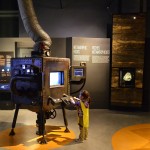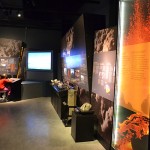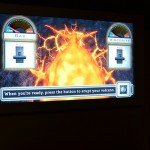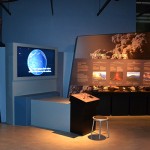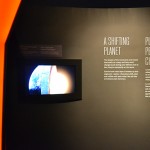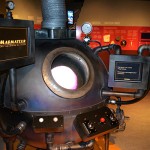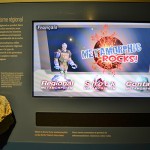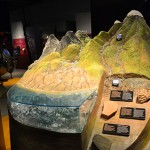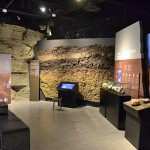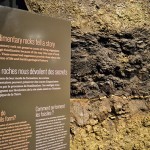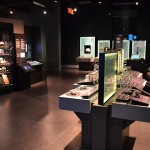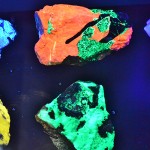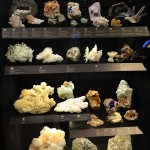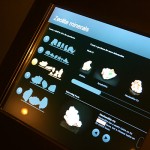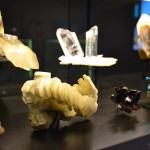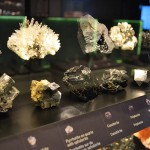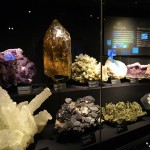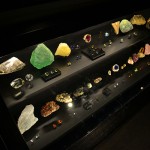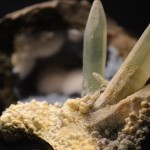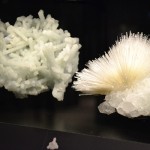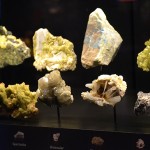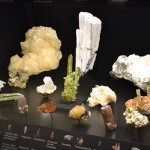
A young visitor uses the Metamorphicator, an interactive learning station, to learn about rock formation at the Canadian Museum of Nature’s Vale Earth Gallery.
A mother walks with her young daughter through the Canadian Museum of Nature’s mammal gallery. The gallery is full of very well-preserved, but very dead animals arranged in dioramas behind glass. The daughter stops briefly at each case to ask her mother, “Is this one real? Is this one real?” “Yes, honey,” the mother says. “They’re real.”
The Canadian Museum of Nature attracts visitors of all kinds. Young families, school groups, adults, and couples of all ages wander the galleries of the spacious heritage building. Constructed in 1912, the Museum of Nature was the first purpose-built museum in Canada.
Anyone who has been to a few museums knows that some exhibits are better than others. The difference between a good exhibit and a lacklustre one becomes especially obvious when children are involved.
Many traditional museum exhibits are behind glass, both literally and figuratively, for visitors. While these can be interesting, they do not provide interactive or tactile experiences, limiting their appeal. Reviewer Philip Scarpino described Museum of Nature’s bird and mammal dioramas as “stunning, but dated.”
This type of exhibit is, indeed, going extinct. The shift towards interactivity and visitor-driven museum experience can be seen throughout the museum, but particularly in its newest permanent gallery, the Vale Earth Gallery, opened in November 2012.
Nicole Dupuis was one of several content developers for the Vale Earth Gallery. With her team, she chose the stories the exhibit would tell, and how they would be told.
What resulted is a fundamentally interactive exhibit in which the science behind rocks and minerals is explained clearly.
Photos from the Vale Earth Gallery:
Photos © Catherine Cross
Content developers as interpreters
One thing that sets the Canadian Museum of Nature apart is that it does not have exhibit curators. Curators are experts in a given field who determine the way an exhibit is done. At the Museum of Nature, content developers are not experts in the science they explain.
Scientists are often criticized for having difficulty explaining their work to the public.
“You can imagine that if a scientist has been working for 20 years on a specific kind of sedimentary rock in the Navajo Desert, they know so much about that topic they would have a hard time simplifying it enough for someone who does not have the same expertise,” says Dupuis.
Content developers at the museum navigate this issue by serving as a go-between for the scientists and the public. The developers asked scientists, in this case geologists, about what was most important and how to best illustrate this information. The content developers then parsed out the most important and interesting information and translated it into accessible exhibits.
“By having someone who is not an expert in the field write the text, we’re a little more aware or sensitive to where the visitor is going to be at with that subject,” says Dupuis.
Dupuis says it’s important that text is very clear, without too many details or complicated information. This encourages the reader to continue reading, rather than feel irritated.
Dupuis points out that many museum visitors come with children. The adult needs to be able to quickly grasp what they are looking at when the child asks, “What’s that?” A well-designed exhibit will do just that. This way, the child gets their answer, and the adult gets the joy of sharing knowledge.
Creating a visitor-driven museum experience
In many traditional museum exhibits, text panels and specimens are meant to be seen in a certain order to tell a particular narrative. Visitors, however, often do not follow an intended order. They wander.
“It’s really important that each text panel or each small section stands on its own,” said Dupuis. This way, the visitor creates his or her own experience, while still receiving the same essential knowledge.
Additionally, by including displays the visitor can touch and not only see, and creating interactive learning centres, the exhibit is able to provide an experience unique to each visitor.
The museum is still working on becoming more interactive. Dupuis says she hopes in the future to test ideas with visitors as they are being developed. The museum hasn’t done this very much yet, but Dupuis says it’s a valuable way to keep track of visitors’ tastes.
“Visitors will tell you very quickly if something doesn’t work for them,” she says.


